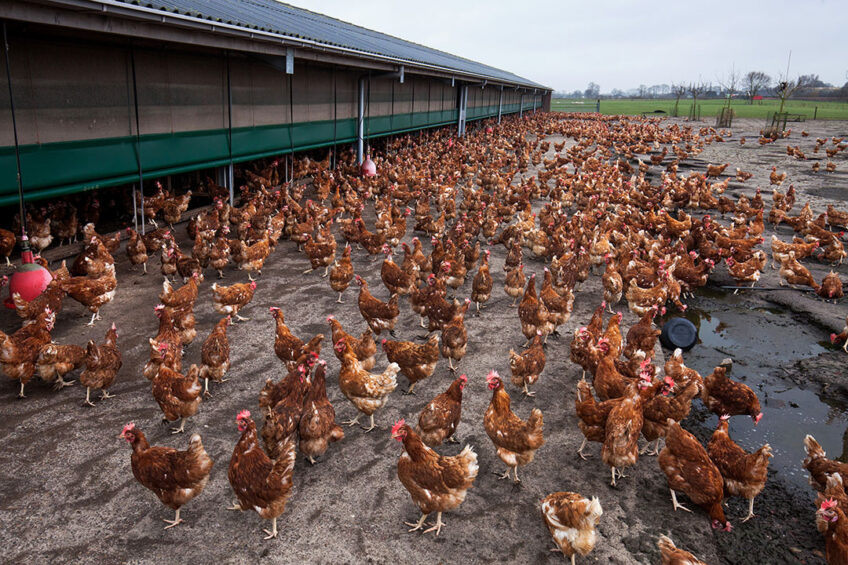Monitoring and controlling worm pressure in poultry

Almost all poultry farmers encounter parasitic gastrointestinal worms in their flocks. The consequences for the birds can be significant. Worms can damage organs and trigger infections. In addition, worms absorb nutrients intended for the layer. The degree of worm pressure and the worm species determines the seriousness of the situation.
Worm pressure expresses the number of adult worms and worm eggs present in a flock at any given moment. The 4 main types of worms are found in organic layers in the Netherlands and Germany. This is evident from several European studies and a survey conducted by organic compound feed producer, Reudink, among organic poultry farmers in the Netherlands and Germany.
Parasitic gastrointestinal worms
In a flock of laying hens with low to medium worm pressure, an infection with large and small roundworms will not have major consequences. Problems will only occur once the worm pressure rises further or in combination with other stressors, such as an E. coli infection or respiratory disease. As a carrier of histomonas, which causes blackhead, the small roundworm poses a potential risk. This disease can be fatal.
A high level of infection pressure caused by the large roundworm can lead to a blockage of the intestine in addition to worms absorbing nutrients intended for the hens. Hens may start to compensate for this and can result in higher feed intake. Fewer nutrients may be available for egg production, which can lead to reduced production and a lower egg weight.
Hairworms nest in the intestinal wall. Intestines and other organs can be damaged, possibly resulting in death. “With a hairworm infection, the flock must be dewormed. This should also be done when the pressure due to large and small roundworms is too high,” says Reudink poultry product manager, Corine Walvoort. She supervised worm research, which will also be relevant for conventional laying hen farmers.
Visualising worm pressure
When controlling worm pressure, it is advisable to first determine the actual pressure. This can be done in 2 ways: by inspecting the gastrointestinal tract of a few animals per barn, or by taking manure samples. The disadvantage of a gastrointestinal inspection is that a significant number of animals must be sacrificed to give a representative picture of the worm pressure, as Walvoort points out. “We therefore recommend taking manure samples first. The number of worm eggs per gramme of manure is expressed as an EPG value.”
Regular sampling is key
Roundworms and hairworms have their own EPG values. The interpretation of the EPG value depends on the worm type, the farm’s history and the flock characteristics. “Based on the available information, we advise poultry farmers to consult their vet about the control plan. When EPG values rise quickly, it is wise to take manure samples more often or to consider deworming in consultation with the poultry vet. If hairworms are shown to be present, it is wise to take immediate action,” says Walvoort.
Walvoort says that regular EPG determination is a good method for gaining insight into the development of worm pressure. “We advise taking manure samples every 2 weeks, up to 30 weeks of age. A cycle of 4 weeks is sufficient for hens older than 30 weeks.”
Proper manure sampling is important to obtain a clear picture of the worm pressure, says Walvoort, who consulted poultry vets from various practices for the study.
Controlling worm pressure
There are several ways to manage worm pressure on a farm. Direct treatment with synthetic agents is often seen as the most effective solution for high worm pressure (approximately 90-95% mortality rate). Anthelmintics can also be used strategically based on the development cycle of the worm (around 3-6 weeks) to minimise the excretion of worm eggs. This treatment method ensures that treatment is also carried out when worm pressure is low. In the long run, this can lead to reduced effectiveness or resistance to these anthelmintics. “A better way is to use worming agents when it is certain that the worm pressure is average to high,” Walvoort adds.
As well as combating worm pressure in the hen, it is also important to take measures to reduce the number of worm eggs in the barn to prevent re-infestation. These measures are aimed at destroying or removing worm eggs. Treatment can deactivate worm eggs by heating them to around 40-50°C or higher.
The farmer can also rinse the barn with large amounts of water containing a cleaning agent. This will not kill the worm eggs but the large volume of water can flush many of them out of the barn. “Try to collect the cleaning water in a drainage pit and not let it end up in the free-range area,” says Walvoort.
Combatting worms in the free-range area
If present, measures can also be taken to combat worms in the free-range area, such as removing manure and ploughing the outdoor area, says Walvoort. “Make sure that paved areas around the barn are thoroughly cleaned. The use of strips with coarse pebbles or boulders in the outdoor area reduces the risk of puddles. This prevents hens from taking in water contaminated with worm eggs. A well-designed range ensures that chickens spread out well. This will help to prevent high concentrations of excrement with worm eggs.”
Join 31,000+ subscribers
Subscribe to our newsletter to stay updated about all the need-to-know content in the poultry sector, three times a week. Beheer
Beheer











 WP Admin
WP Admin  Bewerk bericht
Bewerk bericht